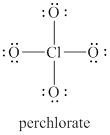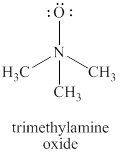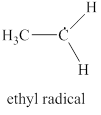
Concept explainers
(a)
Interpretation:
The formal charge on each atom and the net charge in the given species are to be stated.
Concept introduction:
Chemical compounds contain two types of bonds. These are known as ionic and covalent bonds. In ionic bonds, the ions are held by the electrostatic interaction between them. In covalent bonds, the atoms are held together by the sharing of electrons. The formal charge is the charge on the constituent atoms in a molecule. It is calculated by using valence electrons of the atom.
Answer to Problem 1.25AP
The formal charges on oxygen atom and chlorine atom are
Explanation of Solution
The given structure is shown in figure 1.

Figure 1
The formal charge on atom is calculated by the formula given below as,
The valence electrons of oxygen atoms in given species are
Thus, the formal charge on each oxygen atom is
The valence electrons of chlorine atom in given species are
Thus, the formal charge on chlorine atom is
The total charge on the given species is calculated as follows.
Hence, total charge on the species is
The formal charges on oxygen atom and chlorine atom are
(b)
Interpretation:
The formal charge on each atom and the net charge in the given species are to be stated.
Concept introduction:
Chemical compounds contain two types of bonds. These are known as ionic and covalent bonds. In ionic bonds, the ions are held by the electrostatic interaction between them. In covalent bonds, the atoms are held together by the sharing of electrons. The formal charge is the charge on the constituent atoms in a molecule. It is calculated by using valence electrons of the atom.
Answer to Problem 1.25AP
The formal charges on oxygen atom, nitrogen atom and carbon atom are
Explanation of Solution
The given structure is shown in figure 2.

Figure 2
The formal charge on atom is calculated by the formula given below as,
The valence electrons of oxygen atoms in given species are
Thus, the formal charge on each oxygen atom is
The valence electrons of nitrogen atom in given species are
Thus, the formal charge on nitrogen atom is
The valence electrons of carbon atom in given species are
Thus, the formal charge on carbon atom is
The total charge on the given species is calculated as follows.
Hence, total charge on the species is
The formal charges on oxygen atom, nitrogen atom and carbon atom are
(c)
Interpretation:
The formal charge on each atom and the net charge in the given species are to be stated.
Concept introduction:
Chemical compounds contain two types of bonds. These are known as ionic and covalent bonds. In ionic bonds, the ions are held by the electrostatic interaction between them. In covalent bonds, the atoms are held together by the sharing of electrons. The formal charge is the charge on the constituent atoms in a molecule. It is calculated by using valence electrons of the atom.
Answer to Problem 1.25AP
The formal charges on left oxygen atom, right oxygen atom and central oxygen atom are
Explanation of Solution
The given structure is shown in figure 3.

Figure 3
The formal charge on atom is calculated by the formula given below as,
The valence electrons of left oxygen atom in given species are
Thus, the formal charge on each oxygen atom is
The valence electrons of right oxygen atom in given species are
Thus, the formal charge on each oxygen atom is
The valence electrons of central oxygen atom in given species are
Thus, the formal charge on each oxygen atom is
The total charge on the given species is calculated as follows.
Hence, total charge on the species is
The formal charges on left oxygen atom, right oxygen atom and central oxygen atom are
(d)
Interpretation:
The formal charge on each atom and the net charge in the given species are to be stated.
Concept introduction:
Chemical compounds contain two types of bonds. These are known as ionic and covalent bonds. In ionic bonds, the ions are held by the electrostatic interaction between them. In covalent bonds, the atoms are held together by the sharing of electrons. The formal charge is the charge on the constituent atoms in a molecule. It is calculated by using valence electrons of the atom.
Answer to Problem 1.25AP
The formal charge on carbon atom is
Explanation of Solution
The given structure is shown in figure 4.

Figure 4
The formal charge on atom is calculated by the formula given below as,
The valence electrons of carbon atom in given species are
Thus, the formal charge on carbon atom is
Hence, total charge on the species is also
The formal charge on carbon atom is
(e)
Interpretation:
The formal charge on each atom and the net charge in the given species are to be stated.
Concept introduction:
Chemical compounds contain two types of bonds. These are known as ionic and covalent bonds. In ionic bonds, the ions are held by the electrostatic interaction between them. In covalent bonds, the atoms are held together by the sharing of electrons. The formal charge is the charge on the constituent atoms in a molecule. It is calculated by using valence electrons of the atom.
Answer to Problem 1.25AP
The formal charge on carbon atom and carbon radical is
Explanation of Solution
The given structure is shown in figure 5.

Figure 5
The formal charge on atom is calculated by the formula given below as,
The valence electrons of carbon atom in given species are
Thus, the formal charge on carbon atom is
The valence electrons of carbon radical in given species are
Thus, the formal charge on carbon radical is
Hence, total charge on the species is also
The formal charge on carbon atom and carbon radical is
(f)
Interpretation:
The formal charge on each atom and the net charge in the given species are to be stated.
Concept introduction:
Chemical compounds contain two types of bonds. These are known as ionic and covalent bonds. In ionic bonds, the ions are held by the electrostatic interaction between them. In covalent bonds, the atoms are held together by the sharing of electrons. The formal charge is the charge on the constituent atoms in a molecule. It is calculated by using valence electrons of the atom.
Answer to Problem 1.25AP
The formal charge on oxygen atom and chlorine atom is
Explanation of Solution
The given structure is shown in figure 6.

Figure 6
The formal charge on atom is calculated by the formula given below as,
The valence electrons of oxygen atoms in given species are
Thus, the formal charge on each oxygen atom is
The valence electrons of chlorine atom in given species are
Thus, the formal charge on chlorine atom is
The total charge on the given species is calculated as follows.
Hence, total charge on the species is
The formal charge on oxygen atom and chlorine atom is
Want to see more full solutions like this?
Chapter 1 Solutions
Organic Chemistry
- Provide the semi-developed formula of isooxazole obtained by reacting acetylacetone and hydroxylamine.arrow_forwardGiven a 1,3-dicarbonyl compound (R1-CO-CH2-CO-R2), indicate the formula of the compound obtaineda) if I add hydroxylamine (NH2OH) to give an isooxazole.b) if I add thiosemicarbazide (NH2-CO-NH-NH2) to give an isothiazole.arrow_forwardAn orange laser has a wavelength of 610 nm. What is the energy of this light?arrow_forward
- The molar absorptivity of a protein in water at 280 nm can be estimated within ~5-10% from its content of the amino acids tyrosine and tryptophan and from the number of disulfide linkages (R-S-S-R) between cysteine residues: Ε280 nm (M-1 cm-1) ≈ 5500 nTrp + 1490 nTyr + 125 nS-S where nTrp is the number of tryptophans, nTyr is the number of tyrosines, and nS-S is the number of disulfide linkages. The protein human serum transferrin has 678 amino acids including 8 tryptophans, 26 tyrosines, and 19 disulfide linkages. The molecular mass of the most dominant for is 79550. Predict the molar absorptivity of transferrin. Predict the absorbance of a solution that’s 1.000 g/L transferrin in a 1.000-cm-pathlength cuvet. Estimate the g/L of a transferrin solution with an absorbance of 1.50 at 280 nm.arrow_forwardIn GC, what order will the following molecules elute from the column? CH3OCH3, CH3CH2OH, C3H8, C4H10arrow_forwardBeer’s Law is A = εbc, where A is absorbance, ε is the molar absorptivity (which is specific to the compound and wavelength in the measurement), and c is concentration. The absorbance of a 2.31 × 10-5 M solution of a compound is 0.822 at a wavelength of 266 nm in a 1.00-cm cell. Calculate the molar absorptivity at 266 nm.arrow_forward
- How to calculate % of unknown solution using line of best fit y=0.1227x + 0.0292 (y=2.244)arrow_forwardGiven a 1,3-dicarbonyl compound, state the (condensed) formula of the compound obtaineda) if I add hydroxylamine (NH2OH) to give an isooxazole.b) if I add thiosemicarbazide (NH2-CO-NH-NH2) to give an isothiazole.arrow_forwardComplete the following acid-base reactions and predict the direction of equilibrium for each. Justify your prediction by citing pK values for the acid and conjugate acid in each equilibrium. (a) (b) NHs (c) O₂N NH NH OH H₁PO₁arrow_forward
- 23.34 Show how to convert each starting material into isobutylamine in good yield. ཅ ནད ཀྱི (b) Br OEt (c) (d) (e) (f) Harrow_forwardPlease help me Please use https://app.molview.com/ to draw this. I tried, but I couldn't figure out how to do it.arrow_forwardPropose a synthesis of 1-butanamine from the following: (a) a chloroalkane of three carbons (b) a chloroalkane of four carbonsarrow_forward
 ChemistryChemistryISBN:9781305957404Author:Steven S. Zumdahl, Susan A. Zumdahl, Donald J. DeCostePublisher:Cengage Learning
ChemistryChemistryISBN:9781305957404Author:Steven S. Zumdahl, Susan A. Zumdahl, Donald J. DeCostePublisher:Cengage Learning ChemistryChemistryISBN:9781259911156Author:Raymond Chang Dr., Jason Overby ProfessorPublisher:McGraw-Hill Education
ChemistryChemistryISBN:9781259911156Author:Raymond Chang Dr., Jason Overby ProfessorPublisher:McGraw-Hill Education Principles of Instrumental AnalysisChemistryISBN:9781305577213Author:Douglas A. Skoog, F. James Holler, Stanley R. CrouchPublisher:Cengage Learning
Principles of Instrumental AnalysisChemistryISBN:9781305577213Author:Douglas A. Skoog, F. James Holler, Stanley R. CrouchPublisher:Cengage Learning Organic ChemistryChemistryISBN:9780078021558Author:Janice Gorzynski Smith Dr.Publisher:McGraw-Hill Education
Organic ChemistryChemistryISBN:9780078021558Author:Janice Gorzynski Smith Dr.Publisher:McGraw-Hill Education Chemistry: Principles and ReactionsChemistryISBN:9781305079373Author:William L. Masterton, Cecile N. HurleyPublisher:Cengage Learning
Chemistry: Principles and ReactionsChemistryISBN:9781305079373Author:William L. Masterton, Cecile N. HurleyPublisher:Cengage Learning Elementary Principles of Chemical Processes, Bind...ChemistryISBN:9781118431221Author:Richard M. Felder, Ronald W. Rousseau, Lisa G. BullardPublisher:WILEY
Elementary Principles of Chemical Processes, Bind...ChemistryISBN:9781118431221Author:Richard M. Felder, Ronald W. Rousseau, Lisa G. BullardPublisher:WILEY





